10 stages that shook the Tour de France
Procycling picks out the 10 most exciting mountain stages of the post-Merckx era at the Tour de France

With the 2020 Tour de France seemingly ready to run during the new coronavirus-affected dates of August 29 to September 20, we've looked back through the archives to find some of the most exciting stages of the race from the last half century.
Plenty of the biggest names in tour history are here, from Merckx to Hinault and Lemond, as well as a few more recent entries. Scroll down to check out ten stages that shook the Tour de France.
Procycling magazine: the best writing and photography from inside the world's toughest sport. Pick up your copy now in all good newsagents and supermarkets, or get a Procycling subscription.
This article featured in Procycling magazine issue 232, 2017
1975, stage 15, Nice - Pra Loup

Distance: 217.5km
Climbs: Le Col St Martin, Col de la Couillole, Col des Champs, Col d’Allos, Pra-Loup
It wasn’t yet the post-Eddy Merckx era when the peloton rolled out of sea-level Nice and embarked on a steadily rising parcours which would top out at 2,250 metres at the Col d’Allos and finish at the ski station of Pra-Loup, two weeks into the 1975 Tour. In fact, the stage looked just like so many others since 1969, during which time Merckx had been unbeatable at the Tour: the Belgian, in yellow, and, by the way, attacking off the front. Merckx was never one to sit on a lead.
The latest race content, interviews, features, reviews and expert buying guides, direct to your inbox!
However, anybody who’d been reading the runes might have sensed that Merckx was attacking out of insecurity, not confidence. He’d built a lead of 2:20 into the Pyrenees, but Bernard Thévenet, his closest rival, had spent the Pyrenees and Massif Central pruning that lead back. 49 seconds here, 34 seconds there. By the Pra-Loup stage, the Frenchman’s deficit was only 58 seconds.
Merckx attacked over and down the Allos, gaining two minutes by the foot of Pra-Loup. He would surely increase that lead by the top. But instead, the unthinkable happened: he cracked, and Thévenet caught and passed him with enough time to take back the full 58 seconds that separated the two, and another 58 seconds on top of that.
Merckx was fifth on the day. No disaster, but the façade of invincibility was gone forever. Thévenet attacked again the next day, over the Col d’Izoard, and Merckx simply couldn’t follow. The post-Merckx era had begun.
1984, stage 17, Grenoble - Alpe d’Huez
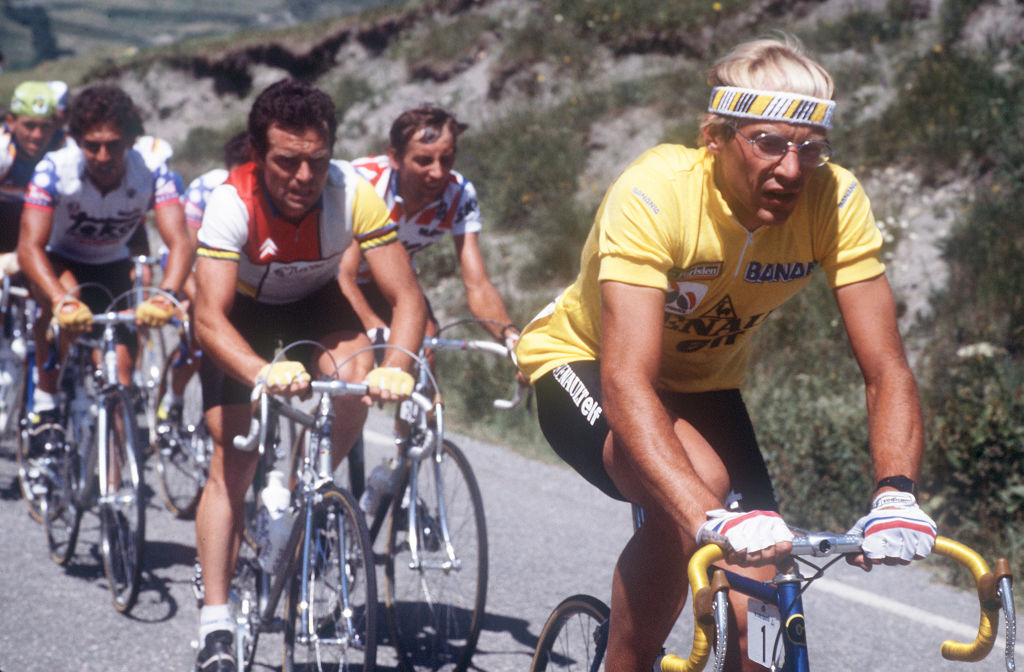
Distance: 151km
Climbs: Côte de St Pierre-de-Chartreuse, Col du Coq, Côte de Laffrey, Alpe d’Huez
The second half of the 151-kilometre Alpe d’Huez stage of the 1984 Tour resembled a toe-to-toe heavyweight fight, two fighters trading blows, one with a little more finesse, the other with increasing desperation.
Laurent Fignon, the defending champion, had spent the first two weeks of the Tour provocatively taking small chunks of time out of Bernard Hinault, the returning four-time winner. Fignon had won in 1983 in Hinault’s absence, and the older rider had a point to prove: that without the debilitating knee injury which kept him from the race the previous year, there was no way he’d have allowed Fignon to win the yellow jersey. But Fignon’s lead over Hinault was already two minutes by the time the 1984 Tour reached the Alps.
The Alpe d’Huez stage avoided the huge climbs to the north and east of the Alpe – the Croix de Fer and Galibier – and instead looped into the narrow, steep, shorter climbs of the Chartreuse, to the west. Hinault attacked on the Laffrey, pulling Fignon and a small group clear. Fignon counterattacked over the top, forcing Hinault to chase. When he caught Fignon, in the valley road to the Alpe, he counterattacked himself, right into a scouring headwind.
Much was made of Fignon’s reaction to Hinault’s attack. He told the press at the finish line, where he’d put almost three minutes into Hinault after catching and dropping the exhausted Breton on the Alpe, that it had made him laugh. The following year, Fignon pulled out with a knee injury while Hinault won the yellow jersey. Hinault might have permitted himself at least a smile at that.
1986, stage 13, Pau - Superbagnères

Distance: 186km
Climbs: Col du Tourmalet, Col d’Aspin, Col de Peyresourde, Superbagnères
Bernard Hinault never saw a fight he didn’t like the look of joining. And if nobody else was fighting, he’d start one anyway.
With one mountain stage down in the 1986 Tour, Hinault had his boot on the throat of the race. He’d promised to help his team-mate Greg LeMond win the yellow jersey, but his actions on the first Pyrenean stage, to Pau, were those of a rider intent on winning himself. He’d attacked with a strong companion, Pedro Delgado. Nobody behind wanted to lead LeMond up to the front, so Hinault and Delgado gained over four and a half minutes.
Hinault and LeMond’s team, La Vie Claire, was by far the strongest in the race – possibly one of the strongest teams ever to start a Tour. There was no need for Hinault to do anything after Pau except cruise round to Paris and win a record sixth Tour. But the next day he attacked, again a long way from the finish, on the descent of the Col du Tourmalet.
He gained another two minutes by the top of the Aspin, but this time, the pursuit from his rivals was committed and he was caught in Luchon, with Superbagnères still to come. Hinault cracked, and LeMond forged ahead to take back every second of the deficit he’d conceded the day before, moving from 5:25 down to within 40 seconds of his teammate. Hinault had effectively delivered a knockout blow – to himself.
1987, stage 19, Valréas – Villard-de-Lans
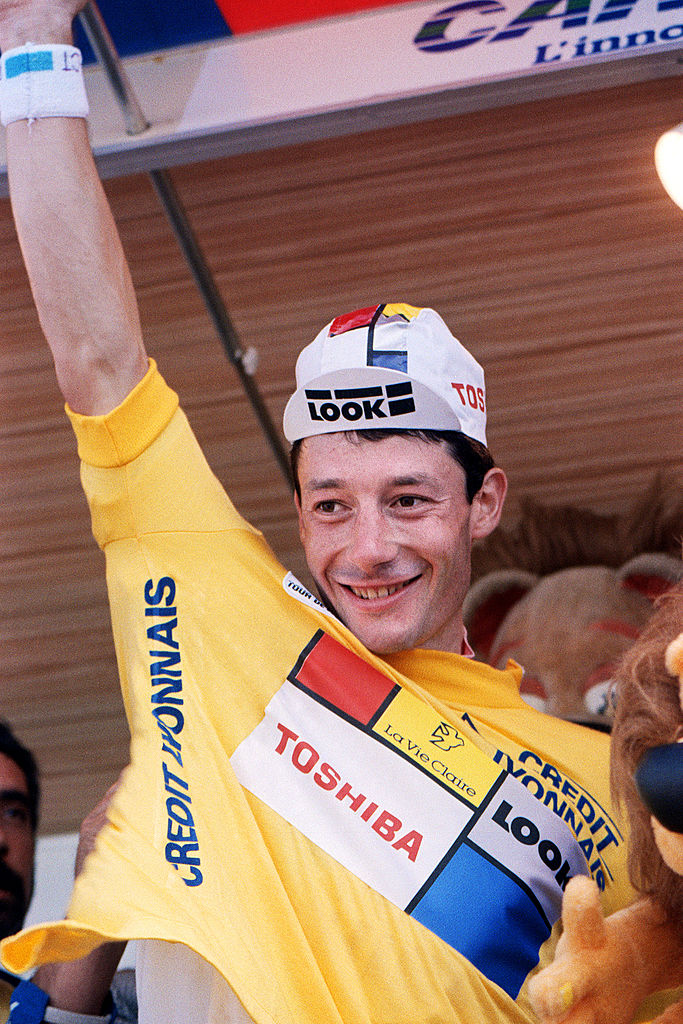
Distance: 185km
Climbs: Col de Tourniol, Col de la Bataille, Col de la Chau, Côte de Chalimont
Before the 1987 Tour ever became Stephen Roche versus Pedro Delgado, it was everybody versus Jean-François Bernard.
Bernard had been riding a blinder. He did a decent long time trial, got into an escape on the first Pyrenean stage and gained almost four minutes on the other GC riders, then rode strongly in the Massif Central. Next came the performance of his career: a hammering of his rivals in the Mont Ventoux time trial that put him two and a half minutes clear in the yellow jersey.
For the French public and media, a new national hero had been anointed, barely six months into the post-Bernard Hinault era. The succession had been seamless – Bernard was dead; long live Bernard. However, there’s a telling line in the eventual 1987 winner Stephen Roche’s autobiography The Agony and the Ecstasy on the younger of the two Frenchmen: “I knew I was going to have a bloody hard job to get Bernard out of the yellow jersey. It was not impossible. He was not Hinault.” Try telling that to the French public.
Bernard might or might not have gone on to win the yellow jersey if he hadn’t punctured at an extremely inopportune moment the day after Ventoux, a grippy middle-mountain stage through the Vercors. His team had sent three riders up the road, leaving him dangerously isolated, and he flatted just as Roche, along with a few others – pretty much everybody else in the final top 10 – attacked through the feed zone.
A 13-rider group, spearheaded by Roche and Delgado, ground out a minute’s lead in the face of spirited resistance from the Frenchman. But then Bernard cracked. The 4-13 he conceded to Roche by the finish was two minutes more than his eventual deficit in Paris. Bernard was not Hinault, and it had taken the Tour one day to find out.
1989, stage 18: Bourg-d’Oisans – Villard-de-Lans

Distance: 91.5km
Climbs: Côte de Laffrey, Côte de St-Nizier-du-Moucherotte, Villard-de-Lans Côte 2000
The recent fad of short, sharp mountain stages is not a new thing. While the postwar Tours, right up to the 2000s, were notable for the epic mountain stages which gave the race its iconography, sometimes the organisers put in a shorter one.
If the 18th stage of the 1989 Tour was anything to go by, they should have embraced the concept as a regular occurrence much sooner. In a race where the lead swung between Greg LeMond and Laurent Fignon, the 91.5km Villard-de-Lans stage was a defining one. LeMond won the long early time trial; Fignon gained at Superbagnères; LeMond took the lead back in the Orcières-Merlette TT and squeezed a little more time out of Fignon in Briançon; the Frenchman struck back on Alpe d’Huez. It seemed that whenever one was strong, the other weakened in turn.
Fignon’s lead after the Alpe was 26 seconds. Not enough against such a strong time triallist as LeMond, with a final day TT in Paris. So he attacked, alone, on the fast, short stage to Villard-de-Lans. LeMond, and the other contenders, were stunned into non-cooperation, before PDM riders Steven Rooks and Gert-Jan Theunisse, who didn’t have a good reason to work, decided to at least regulate Fignon’s lead.
The common wisdom was that Tours were won in the epic mountain stages, but here was Fignon, attacking alone, when everybody would have been comparatively fresh. By the finish, he’d gained 24s. Even against such a strong time triallist as LeMond, 50 seconds should have been enough, but the 1989 Tour was that kind of race.
1990, stage 13: Villard-de-Lans – St-Etienne
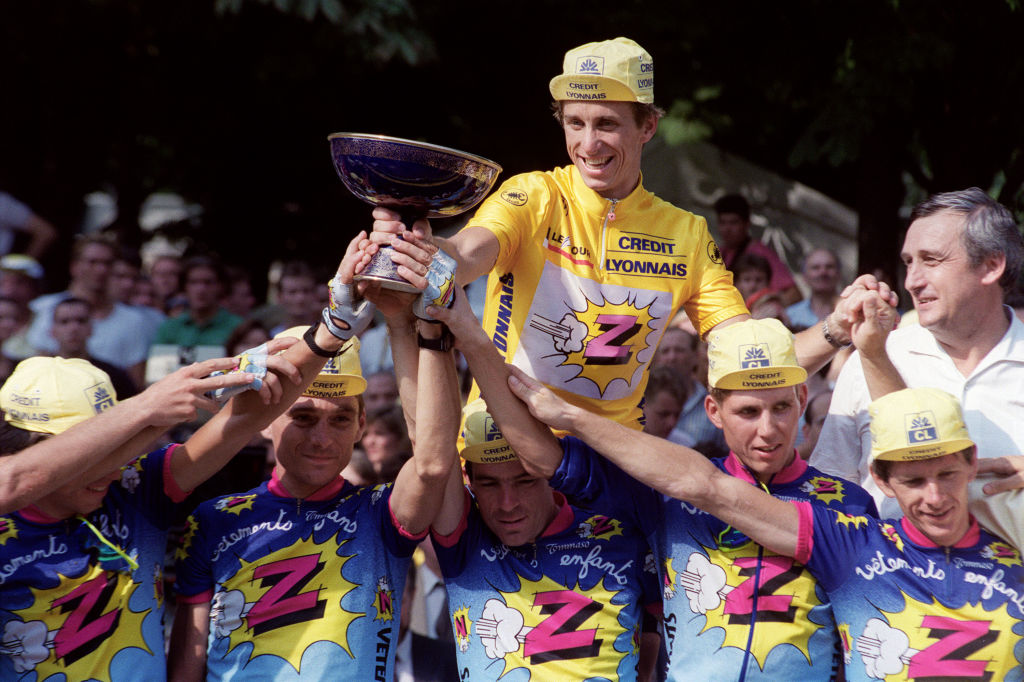
Distance: 149km
Climbs: Col de la Croix de Chaubouret
Getting a rider into a break, the wisdom goes, means that your team doesn’t have to chase. So when Z rider Ronan Pensec slipped into the first break of the 1990 Tour, along with Claudio Chiappucci, Frans Maassen and Steve Bauer, Pensec’s leader Greg LeMond could sit back and let his rivals work out how to reduce their eventual 10-minute deficit. Pensec, after all, had the best climbing pedigree of the four, and if that deficit wasn’t reduced, he would win.
It took two Alpine stages and an uphill time trial to work out that Chiappucci was actually the strongest of the four. When Pensec cracked in the TT and conceded 3:50, it left Chiappucci in yellow, with LeMond in fourth, 7:27 in arrears, and the Alps wasted.
In the Massif Central, on a shortish stage to St Etienne, Z finally got their tactical act together. They sent Pensec up the road in an early attack, forcing Chiappucci and his Carrera team to chase. The effort killed them, and once Pensec was caught, LeMond went on the attack, on the Col de la Croix de Chaubouret above St-Etienne. Chiappucci couldn’t follow, and he shipped five minutes.
It would be another week before LeMond finally took yellow, but while the 1990 Tour is remembered for Chiappucci’s stout defence of the lead in the Pyrenees, his race was lost in a single day in the Massif Central.
1991, stage 13: Jaca – Val Louron
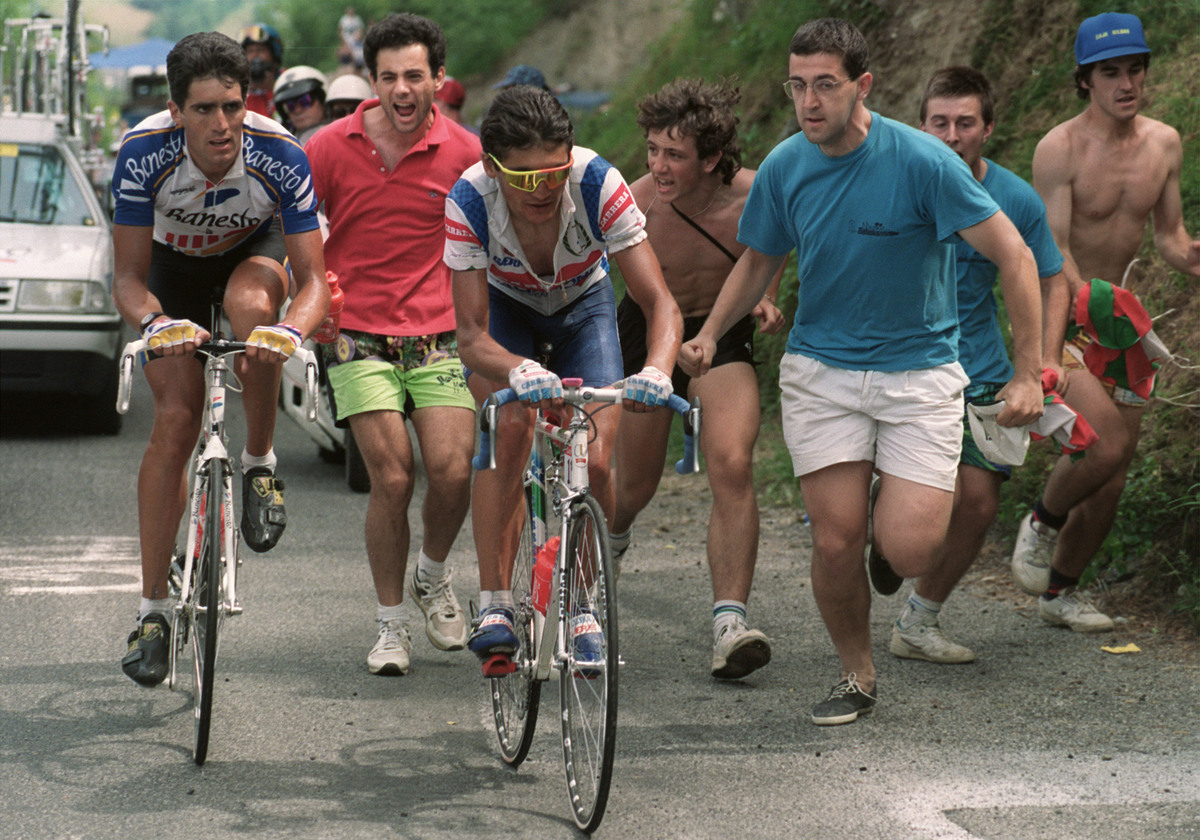
Distance: 232km
Climbs: Col du Pourtalet, Col d’Aubisque, Col du Tourmalet, Col d’Aspin, Val Louron
To paraphrase the former prime minister Gordon Brown, there are two types of pro cyclist: those whose careers slide, and those who get out in time. For Merckx at Pra-Loup and Hinault at Superbagnères, read Greg LeMond at Val Louron.
LeMond was the hot favourite for the 1991 Tour, just as Merckx had been in 1975, and as Hinault had been on the morning of the Superbagnères stage in 1986. He had already led the race, gaining time with audacious attacks on an early flat stage, and in the long time trial. He’d ceded the yellow jersey to long-range escapee Luc Leblanc the day before Val Louron, but he still looked like the eventual winner.
However, it was only when Miguel Indurain did something that rarely happened before or after and attacked on a mountain stage that LeMond started to look shaky. Indurain tore away on the descent of the Tourmalet, hooked up with Claudio Chiappucci, and the pair simply rode away from the race over the final two climbs. LeMond blew, losing a lot of time, and, more fatally, the aura of invincibility he’d built up in winning the last two Tours.
The stage was carnage, with only three more riders within six minutes of the Chiappucci and Indurain tandem. The gaps were race defining and massive, and ushered in a new era whose tactics are still dominant now – a single hammer-blow, followed by catenaccio. The system was developed by Indurain, adopted by Armstrong and perfected by Team Sky.
1998, stage 15: Grenoble – Les Deux Alpes

Distance: 189km
Climbs: Col de la Croix de Fer, Col du Télégraphe, Col du Galibier, Les Deux Alpes
What better symbolism for one of the most notorious stages in modern Tour history than the fact that it took place under black stormclouds, with exhausted and sodden cyclists dimly silhouetted in chiaroscuro by the dirty lamplight of the race vehicles behind?
Marco Pantani went into the hardest stage of the 1998 race three minutes behind defending champion Jan Ullrich. It had been a dreadful Tour. How could a race beleaguered by the Festina scandal not be? The charade went on, as teams were ejected from or left the race, or lost riders to police inquiries. Ullrich had sullenly ground out a seemingly race-winning lead, but it was hard to care.
Did Pantani’s demolition of Ullrich with his spectacular long-range attack through the storm on the Col du Galibier lift the Tour? Or did it just underline the structural problems that existed within the race? A stage which stood comparison with the greatest battles in the Tour’s history brought into stark relief the questions fans have been asking ever since – is any of this actually real?
2008, stage 17: Embrun – Alpe d’Huez
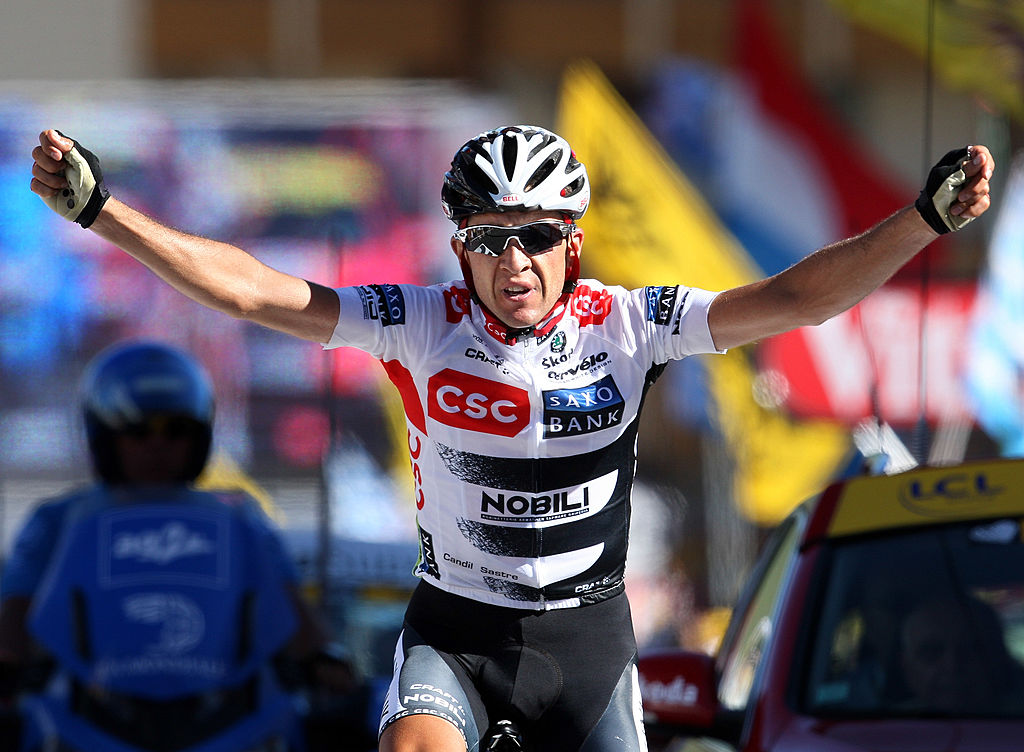
Distance: 210.5km
Climbs: Côte de Ste-Marguerite, Col du Galibier, Col de la Croix de Fer, Alpe d’Huez
Carlos Sastre, the winner of the 2008 Tour, never captured the imagination of fans or other cyclists in the way that other Tour winners did. The rumour went that Lance Armstrong, lounging shirtlessly in retirement on his couch watching the Spaniard win the race, was thus emboldened to make his comeback the following year. (He duly beat Sastre at the 2009 Tour, but it’s uncertain whether it was worth it for the ensuing disgrace.)
Sastre won an open Tour. It was argued that the oft-cited cleaning up of the peloton which may have been starting to happen by then improved the racing. On the other hand, if Alberto Contador had been allowed to start following his Astana team’s own doping travails, it could have been very one-sided.
The race was supremely close throughout, an underrated classic. Going into the final mountain stage at the Alpe, Sastre’s CSC team-mate Fränk Schleck was in yellow, with two riders within 10 seconds, Sastre at 49 seconds and Denis Menchov, at 1:13.
CSC’s problem was that Schleck couldn’t time trial well enough to beat Cadel Evans, at that point eight seconds behind, in the final TT. Schleck’s problem was that the slight figure disappearing into the distance on Alpe d’Huez was his team-mate Sastre.
The Spaniard launched the race-defining attack at the base of the climb, and continued gaining time to the finish, where he had two minutes on his pursuers. Schleck, his hands tied, was forced to grumpily mark Evans up the cimb. Nowhere was the old cliché about cycling being a team sport for individuals any more better illustrated than in Sastre’s Tour-winning attack on the Alpe.
2011, stage 19: Modane – Alpe d’Huez
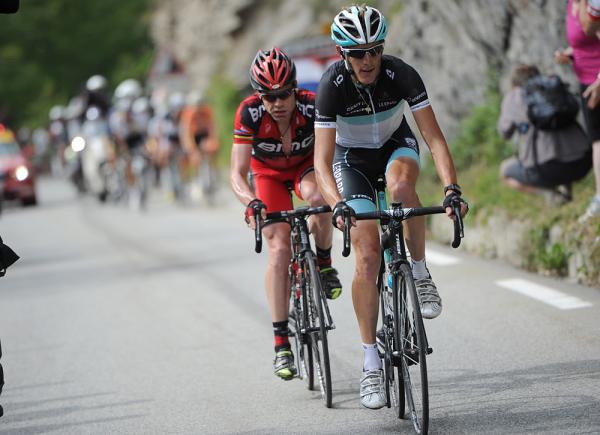
Distance: 109.5km
Climbs: Col du Télégraphe, Col du Galibier, Alpe d'Huez
The 2011 Tour was a slow-burner. Through the first two weeks not much happened in the GC, while Thomas Voeckler surfed a wave of goodwill by wearing yellow after gaining time in a break. The favourites rode cagily through the Pyrenees, with deadlock at Luz Ardiden and Plateau de Beille.
Into the Alps, only a couple of corkscrew descents off small climbs started to create gaps.
The race is famous for Andy Schleck's attack on the stage to the Col du Galibier. Frustrated with his inability to gain time and with his rivals' conservatism, he went on a successful long-range attack, gaining over two minutes on eventual winner Cadel Evans.
But it was the next stage, to Alpe d'Huez, another short, sharp day in the mountains, that detonated the race. Alberto Contador, frustrated with his lack of form, attacked almost immediately, on the Col du Télégraphe. He drew out Schleck and Voeckler, while the race split to pieces behind them.
After almost three weeks of conservative racing, the favourites had attacked inside the first 15 kilometres. Schleck and Contador were chased down on the long descent of the Col du Lautaret, before an all-against-all bar brawl broke out on Alpe d'Huez between Contador, Samuel Sánchez and Pierre Rolland with Rolland taking the honours. Schleck and Evans fought each other to a standstill, while Voeckler battled all the way to fourth place overall. The race had saved the best until last.
How did we choose?
With great difficulty, is the answer. Even applying a cut-off of 1975 (the post-Merckx era), our shortlist was 38 stages long, and we left some crackers on the cutting-room floor even at this point. We limited the selection to no more than one per Tour, not an easy matter in years like 1987 and 1989, when the fortunes of the protagonists ebbed and flowed, day after day.
We also eliminated, in general, some of the great individual and dominant performances. As brilliant as some individual rides have been, we tried to focus on the days when the narrative was twisted, or turned, in some way. Unpredictability is the essence of exciting sport, and these 10 days all demonstrate that, in one way or another.
Follow Procycling on Twitter.
Edward Pickering is Procycling magazine's editor. He graduated in French and Art History from Leeds University and spent three years teaching English in Japan before returning to do a postgraduate diploma in magazine journalism at Harlow College, Essex. He did a two-week internship at Cycling Weekly in late 2001 and didn't leave until 11 years later, by which time he was Cycle Sport magazine's deputy editor. After two years as a freelance writer, he joined Procycling as editor in 2015. He is the author of The Race Against Time, The Yellow Jersey Club and Ronde, and he spends his spare time running, playing the piano and playing taiko drums.